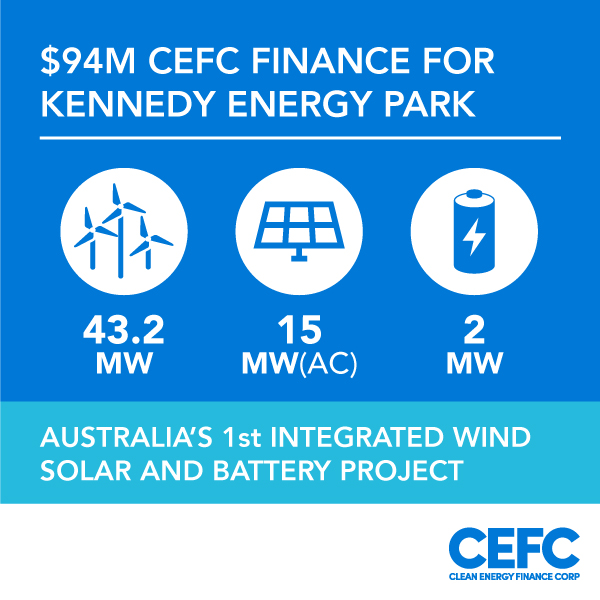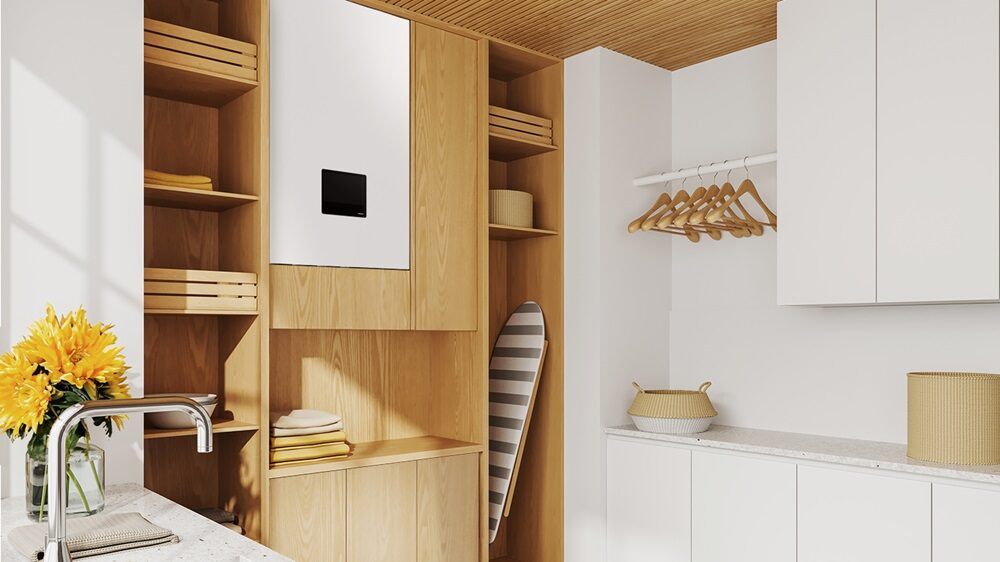The combining of wind and PV generation sources and coupling it with large scale battery storage can deliver reliable renewable energy supply and help balance high levels of intermittent generation on Australia’s electricity network. The deployment of these innovative hybrid arrays has taken a major step forward, with CEFC committing to finance a landmark project in Queensland.
The CEFC will provide $94 million in debt finance to the $170 million Kennedy Energy Park, in central north Queensland. The CEFC reports that financing two generation sources and the battery system at the one site, and in one integrated project, was “a complex undertaking”. The project is the first of its kind in Australia.
“As the sole debt financier for this project, our goal was to demonstrate the bankability of large-scale, integrated hybrid renewable energy projects for the future,” said CEFC Wind Sector Lead Andrew Gardner. “We expect such projects to become an increasingly important part of Australia’s electricity system, with complementary battery storage addressing the intermittency of wind and solar generation to support grid stability.”
Such hybrid solutions are likely to become much common in the Australian renewable marketplace. Signs are that both the Queensland and Victorian government large scale renewable tenders are looking to promote the integration of renewable sources with battery storage, increasing the stability of electricity supply and local grids while at the same time delivering emission-free generation capacity.
Globally, the trend to couple wind and solar alongside battery storage is gaining momentum. UK developer Anesco is rolling out a large scale PV+storage model in Britain, in a series of projects that is breathing life into the country’s PV power plant sector.
Meeting the needs of widespread communities in regional and remote Queensland, the Kennedy Energy Park will supply power to towns across a vast 500-kilometre range. The park will supply remote communities from Julia Creek to Charters Towers in Queensland, the developers report. At the same time, it will help balance the large amounts of rooftop PV being installed in the sprawling district.
“Windlab identified the Kennedy site after confirming its high levels of solar irradiance and world class complementary wind resource,” said CEFC Project lead Bobby Vidakovic. “The natural benefits of the site will deliver high levels of solar energy throughout the day and strong wind generation in the evenings, creating a reliable generation profile around the clock.”
“The addition of the battery component will provide increased grid stability, allowing local communities to benefit from cheaper, cleaner electricity closer to the point of generation, with the added benefit of relieving demand on long transmission lines,” Vidakovic continued.
Windlab is commercializing CSIRO technology that accurately assesses wind generation resources. The CEFC has previously provided $8 million to Windlab to assist it make the transition from project developer, to Independent Power Producer and asset owner.
“Successfully completing this project will also help unlock the enormous potential of Big Kennedy, the 1,200MW wind resource 80 kilometres north of Kennedy Energy Park that will be critical in balancing the large amounts of solar generation that is being added to the Queensland network,” said Canberra-based Windlab CEO Roger Price. He described the development of the project as “enormously challenging yet important.”
Eurus Energy has taken a 50% equity stake in the Kennedy Energy Park.
Twelve months ago, the Australian Renewable Energy Agency (ARENA) committed to providing an $18 million grant for the project.
Where wind and solar resources are complimentary the co-development of projects can benefit from utilizing the same grid connection, significantly decreasing overall costs. It also means that more generation capacity can be added to one site, for the same community engagement cost.
A number of large European utilities, such as Vattenfall, are currently working towards adding solar PV capacity to their existing wind arrays. Chinese wind manufacturer and developer Goldwind is exploring similar projects in Australia and is currently installing its 20 MW White Rock array.
With the further addition of battery storage, the integration of the renewable power into the grid is also assisted. Furthermore, the battery system can also be used to provide auxiliary services to the grid, such as primary reserve control – otherwise known as frequency regulation.
“As the cost of producing electricity from renewable resources continues its rapid downward trajectory, we can expect investors to be increasingly attracted to large-scale hybrid renewable energy projects as the next wave of investment and technological innovation,” concluded the CEFC’s Gardner.
This content is protected by copyright and may not be reused. If you want to cooperate with us and would like to reuse some of our content, please contact: editors@pv-magazine.com.




By submitting this form you agree to pv magazine using your data for the purposes of publishing your comment.
Your personal data will only be disclosed or otherwise transmitted to third parties for the purposes of spam filtering or if this is necessary for technical maintenance of the website. Any other transfer to third parties will not take place unless this is justified on the basis of applicable data protection regulations or if pv magazine is legally obliged to do so.
You may revoke this consent at any time with effect for the future, in which case your personal data will be deleted immediately. Otherwise, your data will be deleted if pv magazine has processed your request or the purpose of data storage is fulfilled.
Further information on data privacy can be found in our Data Protection Policy.